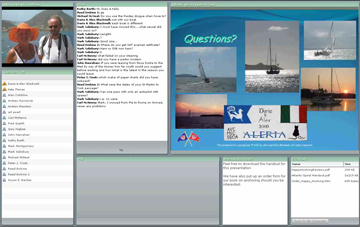 |
||
Knowledge Clinic’s
FIVE Planning Tips for Producing Successful Webinars
To pull off a great webinar, you’ll need to plan ahead. Let’s look at FIVE things you can do to ensure your webinar will be a success.
1. Choose a strong topic and a good title.
| Start with a topic you know well and can speak about for an hour. An hour is about the length of time that is manageable for one person. Often we’ll go to 1.5 hours on a complex subject, especially if we have two speakers and expect lots of questions. You want the topic to be broad enough to allow an hour’s worth of coverage but specific enough to stay focused. Remember, you can always add another webinar as follow-up if you have more to say. |  |
 |
Now you need a title. Choosing a title for your webinar goes far beyond choosing the topic. The title should be specific enough to get across the topic, and intriguing enough to arouse interest in attending. So let’s say you are an expert in mushroom identification. Perhaps your title might be “Foraging for free mushrooms in your own garden.” Or perhaps your topic is yoga for pregnant women. Your title could be “Nine months to an easier delivery through yoga.” The rest can be said in a short descriptive statement that you can use to promote your webinar to your selected target audience. |
2. Decide on a format.
|
There are multiple options for webinar format. You can use a video camera to send images of you in your classroom to your students. You can use a presentation format, like PowerPoint, to create a multiple slide show that you can click through while your voice is projected over it. Or you can use a combination of the two. As you get more comfortable with the technology, you’ll be able to add other techniques, like a whiteboard for virtual sketching or pre-recorded videos to intersperse. Will you be the sole presenter or will you be sharing the virtual podium with other speakers? Will you need a clean desk or an office with good neutral background behind you? Are you going to demonstrate a product or a service? One of the advantages is that you don’t have to be the sole expert. You can hold a dialogue between you and another presenter, you can interview someone else with different experience or a different point of view from yours, or you can do the whole thing yourself. It’s entirely up to you. Naturally, if you share the stage, you might also have to share the revenue. Now you are ready to create the content for your webinar. PowerPoint deck, meditation routine, or outline for a live video feed, you are almost ready to roll. |
3. Identify your audience.
|
Next, pick a day and time. It’s easy to go berserk trying to find a slot that works for everyone in your target audience. Mondays and Fridays are usually tricky, as are weekends. Midweek tends to work reasonably well. Keep in mind that if you are after working people for leisure topics, you’ll need to shoot for 7 pm as a target time. But will it be 7 pm where they are? If you are targeting the UK from Ireland, no problem. If you are reaching out to the US, you’ll need to cover all the time zones between GMT and Pacific time. That means when it is midnight in GMT, it will be 7 pm on the east coast of the states, 5 pm in Chicago, and 4 pm in California. Just realize that no matter how hard you try you won’t be able to pick a time that is convenient for everyone! Instead, pick a time that works for the majority of the audience if you absolutely want the live interactivity and go with it. Webinars are ideal because you can record them and make them available later for those that weren’t able to attend live. |
4. Decide on whether to charge or not.
|
Our system is designed as fee paying and the e-commerce engine is built right in. So, if you charge for your webinar and you have people paying for it, you will receive half the revenues, with the other half going towards costs. If you choose not to charge people to attend, there will be a nominal cost to you to conduct the webinar. |
5. Have backup plans for what you will do if things go amiss
|
Sure, there are things that can go wrong, but if you plan your webinar well, most of them can be avoided. What if no one shows up? Or worse yet, what if two people show up and they are the wrong two people. This is where very careful targeting and promotion are critical for success. Most technical glitches can be handled mid-stream without losing any momentum. Things like volume adjustments, screen sharing layout, or video camera glitches can usually be corrected quickly. If your internet connection is not reliable, however, your likelihood of interruption mid-stream increases; so it is important to conduct your seminar from a location that has reliable broadband and a consistent electrical supply. Keep in mind that live video streaming takes up a lot of bandwidth. If you do not have enough bandwidth, you may not have smooth voice, data and video transmission. That can be annoying to participants and distracting for you.
That’s it! These are the key decisions to make as you get started because they will affect other activities downstream. We’d love your feedback and additional suggestions as you become an expert speaker. We can all be empowered by sharing our experience. |

|
Knowledge Clinic Ltd. - Europe: Port Aleria, Rosnakilly, Kilmeena, Westport, Co. Mayo, Ireland - USA: PO Box 726, Mahwah, NJ 07430
All content on this site is subject to Copyright© 2011 |
|||
 Are you reaching out to people in your local community? Are you looking to expand your influence to a new market? Is your audience scattered around the globe? How will you tell them about your webinar and what means will you use to invite them to take part? Do they have a common interest and are they likely to visit the same websites? Will you advertise to them online, in local newspapers, or magazines? Do you have fans on twitter or Facebook that are just waiting to meet you online? All of these decisions take some advance thought and preparation. Getting the word out to attract people to sign up is half the battle.
Are you reaching out to people in your local community? Are you looking to expand your influence to a new market? Is your audience scattered around the globe? How will you tell them about your webinar and what means will you use to invite them to take part? Do they have a common interest and are they likely to visit the same websites? Will you advertise to them online, in local newspapers, or magazines? Do you have fans on twitter or Facebook that are just waiting to meet you online? All of these decisions take some advance thought and preparation. Getting the word out to attract people to sign up is half the battle. Are you planning to charge for your webinar? If you are promoting your business, then chances are you may wish your webinar to be free of charge. If it is free to attend, you will have to offer really great content to make it worth someone’s time. If you are an expert in a field that people can learn from, consider charging even if you are promoting your business subtly. It will appear less promotional and more valuable, thereby positioning you as the expert and your company as the valued solution without having to state the fact. We have also found that people who sign up for free webinars are not as committed to attending. They need more reminders, and they have little incentive for actually showing up. People who pay for attendance will make every effort to be there. You’ll not only make a bit of pocket change for yourself, you may end up with more impact for your business. Deciding what to charge is the next step. Consider doing a bit of online research to see what others are charging for seminars live or webinars online.
Are you planning to charge for your webinar? If you are promoting your business, then chances are you may wish your webinar to be free of charge. If it is free to attend, you will have to offer really great content to make it worth someone’s time. If you are an expert in a field that people can learn from, consider charging even if you are promoting your business subtly. It will appear less promotional and more valuable, thereby positioning you as the expert and your company as the valued solution without having to state the fact. We have also found that people who sign up for free webinars are not as committed to attending. They need more reminders, and they have little incentive for actually showing up. People who pay for attendance will make every effort to be there. You’ll not only make a bit of pocket change for yourself, you may end up with more impact for your business. Deciding what to charge is the next step. Consider doing a bit of online research to see what others are charging for seminars live or webinars online. Our system has voice over telephone backup to voice over internet protocol (VOIP). So, if you use the VOIP and your connection goes down or your microphone fails, you can always dial in to our service and continue your seminar, or at worst speak to your students to let them know what’s happening. They will hear you through whatever means they were using to connect – either VOIP or phone. Keep a mobile ready to connect with us on a separate line if you need assistance. Having backup microphone and camera options is a good idea. If the failure is beyond our control and cannot be repaired at that time, your choices are to reschedule the class or refund the tuition. People usually understand that technical problems do arise and that gremlins really do exist.
Our system has voice over telephone backup to voice over internet protocol (VOIP). So, if you use the VOIP and your connection goes down or your microphone fails, you can always dial in to our service and continue your seminar, or at worst speak to your students to let them know what’s happening. They will hear you through whatever means they were using to connect – either VOIP or phone. Keep a mobile ready to connect with us on a separate line if you need assistance. Having backup microphone and camera options is a good idea. If the failure is beyond our control and cannot be repaired at that time, your choices are to reschedule the class or refund the tuition. People usually understand that technical problems do arise and that gremlins really do exist.


